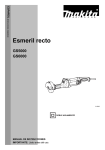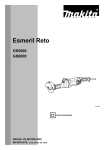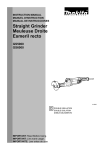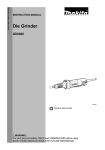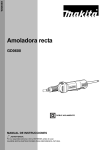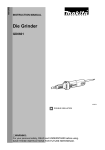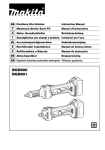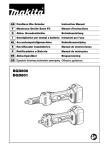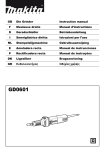Download Makita GS6000 Instruction manual
Transcript
ENGLISH (Original instructions) INSTRUCTION MANUAL Straight Grinder GS5000 GS6000 013595 DOUBLE INSULATION IMPORTANT: Read Before Using. 1 ENGLISH (Original instructions) SPECIFICATIONS Model GS5000 GS6000 Maximum wheel capacity (diameter x thickness) 125 mm × 20 mm 150 mm × 20 mm Spindle thread M14 or 1/2" (country specific) No load speed (min-1) Overall length Net weight 5,600 With support cover 590 mm 590 mm Without support cover 588 mm 588 mm With support cover 5.0 kg 5.2 kg Without support cover 4.9 kg 5.0 kg Safety class /II • Due to our continuing program of research and development, the specifications herein are subject to change without notice. • Specifications may differ from country to country. • Weight according to EPTA-Procedure 01/2003 END202-7 GEA005-3 Symbols General Power Tool Safety Warnings The following show the symbols used for the equipment. Be sure that you understand their meaning before use. ・ Read instruction manual. ・ DOUBLE INSULATION ・ Wear safety glasses. ・ Only for EU countries Do not dispose of electric equipment together with household waste material! In observance of European Directive 2012/19/EU on waste electric and electronic equipment and its implementation in accordance with national law, electric equipment that have reached the end of their life must be collected separately and returned to an environmentally compatible recycling facility. WARNING Read all safety warnings and all instructions. Failure to follow the warnings and instructions may result in electric shock, fire and/or serious injury. Save all warnings and instructions for future reference. The term "power tool" in the warnings refers to your mains-operated (corded) power tool or battery-operated (cordless) power tool. Work area safety 1. Keep work area clean and well lit. Cluttered or dark areas invite accidents. 2. Do not operate power tools in explosive atmospheres, such as in the presence of flammable liquids, gases or dust. Power tools create sparks which may ignite the dust or fumes. 3. Keep children and bystanders away while operating a power tool. Distractions can cause you to lose control. Electrical safety 4. Power tool plugs must match the outlet. Never modify the plug in any way. Do not use any adapter plugs with earthed (grounded) power tools. Unmodified plugs and matching outlets will reduce risk of electric shock. 5. Avoid body contact with earthed or grounded surfaces such as pipes, radiators, ranges and refrigerators. There is an increased risk of electric shock if your body is earthed or grounded. 6. Do not expose power tools to rain or wet conditions. Water entering a power tool will increase the risk of electric shock. ENE050-1 Intended use The tool is intended for grinding ferrous materials or deburring castings. ENF002-2 Power supply The tool should be connected only to a power supply of the same voltage as indicated on the nameplate, and can only be operated on single-phase AC supply. They are double-insulated and can, therefore, also be used from sockets without earth wire. 2 Power tool use and care 18. Do not force the power tool. Use the correct power tool for your application. The correct power tool will do the job better and safer at the rate for which it was designed. 19. Do not use the power tool if the switch does not turn it on and off. Any power tool that cannot be controlled with the switch is dangerous and must be repaired. 20. Disconnect the plug from the power source and/or the battery pack from the power tool before making any adjustments, changing accessories, or storing power tools. Such preventive safety measures reduce the risk of starting the power tool accidentally. 21. Store idle power tools out of the reach of children and do not allow persons unfamiliar with the power tool or these instructions to operate the power tool. Power tools are dangerous in the hands of untrained users. 22. Maintain power tools. Check for misalignment or binding of moving parts, breakage of parts and any other condition that may affect the power tool’s operation. If damaged, have the power tool repaired before use. Many accidents are caused by poorly maintained power tools. 23. Keep cutting tools sharp and clean. Properly maintained cutting tools with sharp cutting edges are less likely to bind and are easier to control. 24. Use the power tool, accessories and tool bits etc. in accordance with these instructions, taking into account the working conditions and the work to be performed. Use of the power tool for operations different from those intended could result in a hazardous situation. Service 25. Have your power tool serviced by a qualified repair person using only identical replacement parts. This will ensure that the safety of the power tool is maintained. 26. Follow instruction for lubricating and changing accessories. 27. Keep handles dry, clean and free from oil and grease. 7. Do not abuse the cord. Never use the cord for carrying, pulling or unplugging the power tool. Keep cord away from heat, oil, sharp edges or moving parts. Damaged or entangled cords increase the risk of electric shock. 8. When operating a power tool outdoors, use an extension cord suitable for outdoor use. Use of a cord suitable for outdoor use reduces the risk of electric shock. 9. If operating a power tool in a damp location is unavoidable, use a residual current device (RCD) protected supply. Use of an RCD reduces the risk of electric shock. 10. Use of power supply via a RCD with a rated residual current of 30mA or less is always recommended. Personal safety 11. Stay alert, watch what you are doing and use common sense when operating a power tool. Do not use a power tool while you are tired or under the influence of drugs, alcohol or medication. A moment of inattention while operating power tools may result in serious personal injury. 12. Use personal protective equipment. Always wear eye protection. Protective equipment such as dust mask, non-skid safety shoes, hard hat, or hearing protection used for appropriate conditions will reduce personal injuries. 13. Prevent unintentional starting. Ensure the switch is in the off-position before connecting to power source and/or battery pack, picking up or carrying the tool. Carrying power tools with your finger on the switch or energising power tools that have the switch on invites accidents. 14. Remove any adjusting key or wrench before turning the power tool on. A wrench or a key left attached to a rotating part of the power tool may result in personal injury. 15. Do not overreach. Keep proper footing and balance at all times. This enables better control of the power tool in unexpected situations. 16. Dress properly. Do not wear loose clothing or jewellery. Keep your hair, clothing, and gloves away from moving parts. Loose clothes, jewellery or long hair can be caught in moving parts. 17. If devices are provided for the connection of dust extraction and collection facilities, ensure these are connected and properly used. Use of dust collection can reduce dustrelated hazards. 3 GEB108-3 protectors, gloves and workshop apron capable of stopping small abrasive or workpiece fragments. The eye protection must be capable of stopping flying debris generated by various operations. The dust mask or respirator must be capable of filtrating particles generated by your operation. Prolonged exposure to high intensity noise may cause hearing loss. 9. Keep bystanders a safe distance away from work area. Anyone entering the work area must wear personal protective equipment. Fragments of workpiece or of a broken accessory may fly away and cause injury beyond immediate area of operation. 10. Hold the power tool by insulated gripping surfaces only, when performing an operation where the cutting accessory may contact hidden wiring or its own cord. Cutting accessory contacting a "live" wire may make exposed metal parts of the power tool "live" and could give the operator an electric shock. 11. Position the cord clear of the spinning accessory. If you lose control, the cord may be cut or snagged and your hand or arm may be pulled into the spinning accessory. 12. Never lay the power tool down until the accessory has come to a complete stop. The spinning accessory may grab the surface and pull the power tool out of your control. 13. Do not run the power tool while carrying it at your side. Accidental contact with the spinning accessory could snag your clothing, pulling the accessory into your body. 14. Regularly clean the power tool’s air vents. The motor’s fan will draw the dust inside the housing and excessive accumulation of powdered metal may cause electrical hazards. 15. Do not operate the power tool near flammable materials. Sparks could ignite these materials. 16. Do not use accessories that require liquid coolants. Using water or other liquid coolants may result in electrocution or shock. Kickback and Related Warnings Kickback is a sudden reaction to a pinched or snagged rotating wheel, backing pad, brush or any other accessory. Pinching or snagging causes rapid stalling of the rotating accessory which in turn causes the uncontrolled power tool to be forced in the direction opposite of the accessory’s rotation at the point of the binding. For example, if an abrasive wheel is snagged or pinched by the workpiece, the edge of the wheel that is entering into the pinch point can dig into the surface of the material causing the wheel to climb out or kick out. The wheel may either jump toward or away from the STRAIGHT GRINDER SAFETY WARNINGS Safety Warnings Common for Grinding Operation: 1. This power tool is intended to function as a grinder. Read all safety warnings, instructions, illustrations and specifications provided with this power tool. Failure to follow all instructions listed below may result in electric shock, fire and/or serious injury. 2. Operations such as sanding, wire brushing, polishing or cutting-off are not recommended to be performed with this power tool. Operations for which the power tool was not designed may create a hazard and cause personal injury. 3. Do not use accessories which are not specifically designed and recommended by the tool manufacturer. Just because the accessory can be attached to your power tool, it does not assure safe operation. 4. The rated speed of the accessory must be at least equal to the maximum speed marked on the power tool. Accessories running faster than their rated speed can break and fly apart. 5. The outside diameter and the thickness of your accessory must be within the capacity rating of your power tool. Incorrectly sized accessories cannot be adequately guarded or controlled. 6. Threaded mounting of accessories must match the grinder spindle thread. For accessories mounted by flanges, the arbour hole of the accessory must fit the locating diameter of the flange. Accessories that do not match the mounting hardware of the power tool will run out of balance, vibrate excessively and may cause loss of control. 7. Do not use a damaged accessory. Before each use inspect the accessory such as abrasive wheels for chips and cracks. If power tool or accessory is dropped, inspect for damage or install an undamaged accessory. After inspecting and installing an accessory, position yourself and bystanders away from the plane of the rotating accessory and run the power tool at maximum no-load speed for one minute. Damaged accessories will normally break apart during this test time. 8. Wear personal protective equipment. Depending on application, use face shield, safety goggles or safety glasses. As appropriate, wear dust mask, hearing 4 Flanges for cut-off wheels may be different from grinding wheel flanges. f) Do not use worn down wheels from larger power tools. Wheel intended for larger power tool is not suitable for the higher speed of a smaller tool and may burst. Additional Safety Warnings: 17. Be careful not to damage the spindle, the flange (especially the installing surface) or the lock nut. Damage to these parts could result in wheel breakage. 18. Make sure the wheel is not contacting the workpiece before the switch is turned on. 19. Before using the tool on an actual workpiece, let it run for a while. Watch for vibration or wobbling that could indicate poor installation or a poorly balanced wheel. 20. Use the specified surface of the wheel to perform the grinding. 21. Do not leave the tool running. Operate the tool only when hand-held. 22. Do not touch the workpiece immediately after operation; it may be extremely hot and could burn your skin. 23. Observe the instructions of the manufacturer for correct mounting and use of wheels. Handle and store wheels with care. 24. Use only flanges specified for this tool. 25. Check that the workpiece is properly supported. 26. Pay attention that the wheel continues to rotate after the tool is switched off. 27. If working place is extremely hot and humid, or badly polluted by conductive dust, use a short-circuit breaker (30 mA) to assure operator safety. 28. Do not use the tool on any materials containing asbestos. 29. Always be sure you have a firm footing. Be sure no one is below when using the tool in high locations. operator, depending on direction of the wheel’s movement at the point of pinching. Abrasive wheels may also break under these conditions. Kickback is the result of power tool misuse and/or incorrect operating procedures or conditions and can be avoided by taking proper precautions as given below. a) Maintain a firm grip on the power tool and position your body and arm to allow you to resist kickback forces. Always use auxiliary handle, if provided, for maximum control over kickback or torque reaction during start-up. The operator can control torque reactions or kickback forces, if proper precautions are taken. b) Never place your hand near the rotating accessory. Accessory may kickback over your hand. c) Do not position your body in the area where power tool will move if kickback occurs. Kickback will propel the tool in direction opposite to the wheel’s movement at the point of snagging. d) Use special care when working corners, sharp edges etc. Avoid bouncing and snagging the accessory. Corners, sharp edges or bouncing have a tendency to snag the rotating accessory and cause loss of control or kickback. e) Do not attach a saw chain woodcarving blade or toothed saw blade. Such blades create frequent kickback and loss of control. Safety Warnings Specific for Grinding: a) Use only wheel types that are recommended for your power tool and the specific guard designed for the selected wheel. Wheels for which the power tool was not designed cannot be adequately guarded and are unsafe. b) The grinding surface of centre depressed wheels must be mounted below the plane of the guard lip. An improperly mounted wheel that projects through the plane of the guard lip cannot be adequately protected. c) The guard must be securely attached to the power tool and positioned for maximum safety, so the least amount of wheel is exposed towards the operator. The guard helps to protect the operator from broken wheel fragments, accidental contact with wheel and sparks that could ignite clothing. d) Wheels must be used only for recommended applications. For example: do not grind with the side of cut-off wheel. Abrasive cut-off wheels are intended for peripheral grinding, side forces applied to these wheels may cause them to shatter. e) Always use undamaged wheel flanges that are of correct size and shape for your selected wheel. Proper wheel flanges support the wheel thus reducing the possibility of wheel breakage. SAVE THESE INSTRUCTIONS. WARNING: DO NOT let comfort or familiarity with product (gained from repeated use) replace strict adherence to safety rules for the subject product. MISUSE or failure to follow the safety rules stated in this instruction manual may cause serious personal injury. 5 ASSEMBLY FUNCTIONAL DESCRIPTION • CAUTION: Always be sure that the tool is switched off and unplugged before adjusting or checking function on the tool. • CAUTION: Always be sure that the tool is switched off and unplugged before carrying out any work on the tool. Switch action 1 1. Switch trigger 2. Lock lever 5 2 1. Hex wrench 2. Hex bolt 3. Hex lock nut 4. Tighten 5. Loosen 4 1 B A 3 2 C 013669 010640 • CAUTION: Before plugging in the tool, always check to see the switch trigger actuates properly and returns to the "OFF" position when released. For tool with the lock-on switch • CAUTION: When the wheel cover is positioned for more safety, tighten the two hex bolts by the strength more than 10N.m to secure the wheel cover properly. Installing or removing grinding wheel CAUTION: Switch can be locked in "ON" position for ease of operator comfort during extended use. Apply caution when locking tool in "ON" position and maintain firm grasp on tool. To start the tool, simply pull the switch trigger (in the B direction). Release the switch trigger to stop. For continuous operation, pull the switch trigger (in the B direction) and then push in the lock lever (in the A direction). To stop the tool from the locked position, pull the switch trigger fully (in the B direction), then release it. For tool with the lock-off switch To prevent the switch trigger from accidentally pulled, a lock lever is provided. To start the tool, push in the lock lever (in the A direction) and then pull the switch trigger (in the B direction). Release the switch trigger to stop. For tool with the lock on and lock-off switch To prevent the switch trigger from accidentally pulled, a lock lever is provided. To start the tool, push in the lock lever (in the A direction) and then pull the switch trigger (in the B direction). Release the switch trigger to stop. For continuous operation, push in the lock lever (in the A direction), pull the switch trigger (in the B direction) and then pull the lock lever (in the C direction). To stop the tool from the locked position, pull the switch trigger fully (in the B direction), then release it. CAUTION: Before installing grinding wheel, always check that a blotter part does not have any abnormalities such as chips or cracks. • Overtightening the wheel can cause breakage. Failure to tighten sufficiently will cause flutter. Tighten the outer flange properly. • Always use the grinding wheel with the blotter that has larger diameter than the lock nut or the outer flange and the inner flange. For tool with support cover only (country specific) • • 1 1. Wing bolt 2. Support cover 2 013624 Before installing or removing the grinding wheel, open the support cover. Loosen the wing bolts on both sides of the support cover and then open it. After securing the wheel grinding, close the support cover and then secure the wing bolts properly. 6 Securing method for type B and C For all tools Type A 3 2 1. Screwdriver 2. Hex wrench 3. Inner flange 4. Hex nut 1 1. Lock nut 2. Grinding wheel 3. Spindle 2 3 4 1 013670 Insert screwdriver into the hole in the inner flange. Grip the hex nut with the wrench, turning in the direction of wheel rotation to loosen the hex nut. Remove the hex nut and outer flange. Then install the wheel, outer flange and hex nut. Tighten the hex nut in the direction of arrow as shown in the figure. 013674 Securing method for type A 1. Screwdriver 2. Inner flange 3. Lock nut wrench 4. Lock nut 1 OPERATION 3 2 4 013673 • Insert screwdriver into the hole in the inner flange. Grip the lock nut with the lock nut wrench, turning in the direction of wheel rotation to loosen the lock nut. Remove the lock nut. Then install the wheel and tighten the lock nut in the direction of arrow as shown in the figure. Type B 3 1 • • 1. Hex nut 2. Outer flange (convex type) 3. Grinding wheel 4. Spindle 4 2 013671 013600 Type C Hanger (optional accessory) 3 1 CAUTION: Apply light pressure on the tool. Excessive pressure on the tool will only cause a poor finish and overloading of the motor. The grinding wheel continues to rotate after the tool is switched off. Hold the tool firmly with one hand on the switch handle and the other hand on the front grip when performing the tool. 4 1. Hex nut 2. Outer flange (flat type) 3. Grinding wheel 4. Spindle 2 013672 013599 Continuous operation of the grinder is made easy by using the handy hanger as shown in the figure. Simply loop the cord over the head or shoulder, after threading 7 it through the eyelet on the top of the tool housing. 2 MAINTENANCE • • 5 1 CAUTION: Always be sure that the tool is switched off and unplugged before attempting to perform inspection or maintenance. Never use gasoline, benzine, thinner, alcohol or the like. Discoloration, deformation or cracks may result. 4 4 3 2 5 1 1. Exhaust vent 2. Inhalation vent 1 3 2 1. Hook B 2. Hook A 3. Rib A 4. Vent A 5. vent B 013614 The tool and its air vents have to be kept clean. Regularly clean the tool's air vents or whenever the vents start to become obstructed. 013620 To install the attachments, insert hook A and rib A into vent A lightly. Insert hook B into vent B. Installing or removing dust cover (optional accessory) • • • • CAUTION: Always be sure that the tool is switched off and unplugged before installing or removing the dust cover attachments. Failure to do so causes damage to the tool or a personal injury. Clean the dust cover attachments when the flow of the air through the dust cover attachments becomes obstructed with built up dust or foreign matters. Continued operation in such a condition may damage the tool. When removing the dust cover attachments, forcing it up without unhooking hook A or B may break hooking part. 3 2 1. Handle R 2. Dust cover attachment R 3. Handle L 4. Dust cover attachment L 1 4 1 2 1. Dust cover attachment R 2. Dust cover attachment L 3. Screwdriver 013743 To remove, lift it up by using a slotted bit screwdriver near the hook B. Also lift it up near the hook A. 3 013619 NOTE: Dust cover attachments installed on GS5000 and GS6000 do not cover the vents above and below the brush holder which is designed dust-proof. Dust cover attachment R/L are respectively installed on the handles R/L with the sides shown above facing toward the tool. 8 Replacing carbon brushes 2 1. Commutator 2. Insulating tip 3. Carbon brush 1 3 001146 When the resin insulating tip inside the carbon brush is exposed to contact the commutator, it will automatically shut off the motor. When this occurs, both carbon brushes should be replaced. Keep the carbon brushes clean and free to slip in the holders. Both carbon brushes should be replaced at the same time. Use only identical carbon brushes. 1. Brush holder cap 2. Screwdriver 1 2 013603 Use a screwdriver to remove the brush holder caps. Take out the worn carbon brushes, insert the new ones and secure the brush holder caps. To maintain product SAFETY and RELIABILITY, repairs, any other maintenance or adjustment should be performed by Makita Authorized Service Centers, always using Makita replacement parts. OPTIONAL ACCESSORIES CAUTION: These accessories or attachments are recommended for use with your Makita tool specified in this manual. The use of any other accessories or attachments might present a risk of injury to persons. Only use accessory or attachment for its stated purpose. If you need any assistance for more details regarding these accessories, ask your local Makita Service Center. • Hex wrench • Wrench holder • NOTE: • Some items in the list may be included in the tool package as standard accessories. They may differ from country to country. 9 10 11 Makita Corporation 885199-0 12 www.makita.com












